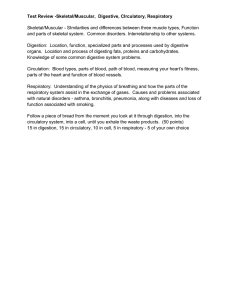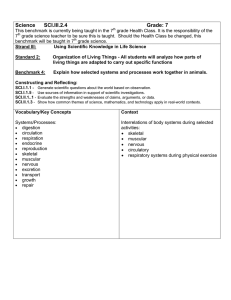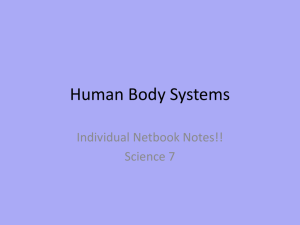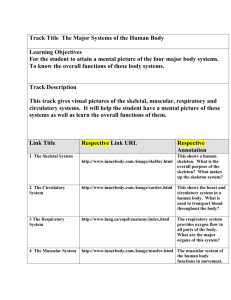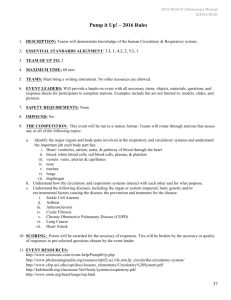Document 10777591
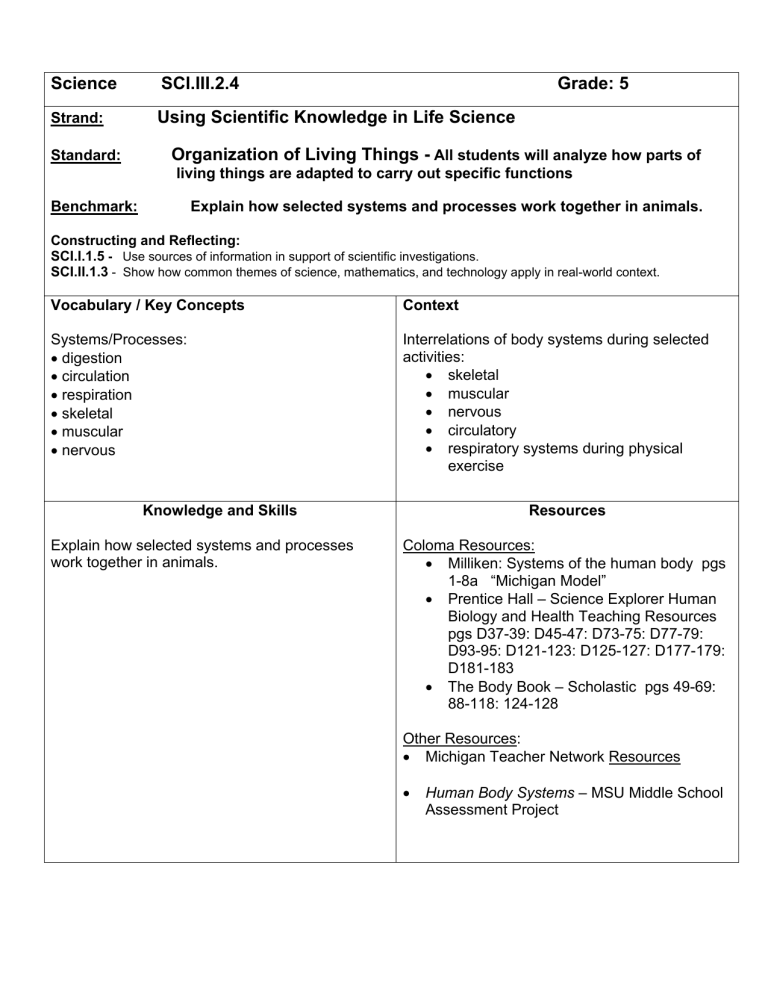
Science SCI.III.2.4 Grade: 5
Strand:
Using Scientific Knowledge in Life Science
Standard:
Organization of Living Things -
All students will analyze how parts of
living things are adapted to carry out specific functions
Benchmark: Explain how selected systems and processes work together in animals.
Constructing and Reflecting:
SCI.I.1.5
- Use sources of information in support of scientific investigations.
SCI.II.1.3
- Show how common themes of science, mathematics, and technology apply in real-world context.
Vocabulary / Key Concepts
Systems/Processes:
•
digestion
•
circulation
•
respiration
•
skeletal
•
muscular
•
nervous
Context
Interrelations of body systems during selected activities:
•
skeletal
•
muscular
•
nervous
•
circulatory
•
respiratory systems during physical exercise
Knowledge and Skills
Explain how selected systems and processes work together in animals.
Resources
Coloma Resources:
•
Milliken: Systems of the human body pgs
1-8a “Michigan Model”
•
Prentice Hall – Science Explorer Human
Biology and Health Teaching Resources pgs D37-39: D45-47: D73-75: D77-79:
D93-95: D121-123: D125-127: D177-179:
D181-183
•
The Body Book – Scholastic pgs 49-69:
88-118: 124-128
Other Resources:
•
Michigan Teacher Network Resources
•
Human Body Systems – MSU Middle School
Assessment Project
Other Resources (continued from above)
Inner Learning Online – interactive anatomy
•
Web site : (Bill Nye Videos)
•
http://curry.edschool.virginia.edu/go/frog/men u.html
•
Virtual Frog Dissection Kit
•
New Directions Teaching Unit : Food, Energy and Growth
Videoconferences Available
For more information, see www.remc11.k12.mi.us/dl or call Janine Lim 471-
7725x101 or email jlim@remc11.k12.mi.us
III.2.MS.4
Bone-A-Fied Facts from the Adventure Science
Center
Deadly Smoke: Respiratory System from Clarian
Health
Journey Inward: Exploring the Human Body from
COSI Toledo
Brainstorm: The body's mission control center from HealthSpace Cleveland
The Human Body: Skeletal System from the
Liberty Science Center
The Human Body: Bio-mechanics from the
Liberty Science Center
The Human Body: Circulatory System from the
Liberty Science Center
Have the students work in small groups to write and perform a play that shows the functions and interactions among the circulatory, respiratory, and digestive systems.
In their groups, they will:
•
Select a body system
•
Assign roles for each group member/organ
•
Write a short skit connecting the actor’s action with their specific organ(s).
•
Perform the skit for the rest of the class
To culminate the activity, the class will create an interactive play that combines the three body systems. After the class play, a discussion could review:
•
The function of the body systems.
•
How systems work together to carry oxygen and nutrients to the cells and remove waste from the cells.
Instruction Assessment
Optional Assessment:
Complete an oral presentation on the selected body system.
Students will collaborate in small groups to write and produce a play showing the functions of the circulatory, digestive, and respiratory systems. The groups will present their plays to an audience other than their class, such as the PT0, other classes, and civic groups. Each group will submit their script for evaluation.
(Give students rubric before activity.)
Scoring Rubric
Criteria: Accurate explanation of functions :
Apprentice - Explains functions of one to two systems, but gives sketchy details.
Basic - Explains functions of three systems, but gives little detail about how they interrelate.
Meets - Explains functions of all three systems and discusses how they work together.
Exceeds - Explains in detail the functions of all three systems and discusses how they work successfully together.
Criteria: Effectiveness of collaboration :
Apprentice - Participates with some team members in writing, performing, or producing the play.
Basic - Participates with most team members in writing, performing, or producing the play.
Meets - Participates with all team members in writing, performing, or producing the play.
Exceeds - Participates with all team members equally in writing, performing, or producing the play.
Teacher Notes:
“The human organism has systems for digestion, respiration, reproduction, circulation, excretion, movement, control, and coordination, and for protection from disease. These systems interact with one another.” (NSES) For example, the skeletal and muscular systems work together to provide support and locomotion; the digestive, circulatory, respiratory and excretory systems work together to get energy-containing substances to the cells and waste products out of the body; the nervous and endocrine systems work together to allow the organism to respond to events in its environment.(JCISD)
The benchmark about systems and processes in animals does not require students to name the parts of each system.
They need to learn the functions of each system and how systems work together to accomplish those functions.
The emphasis in this unit is on human body systems, although what students learn is applicable to many other animals.
(JCISD)
Focus Question
How do our body systems work together?

